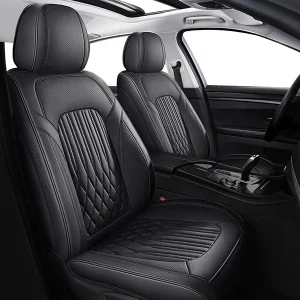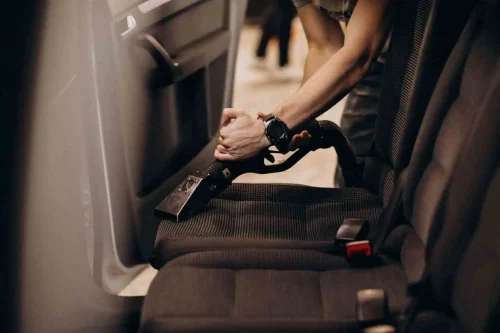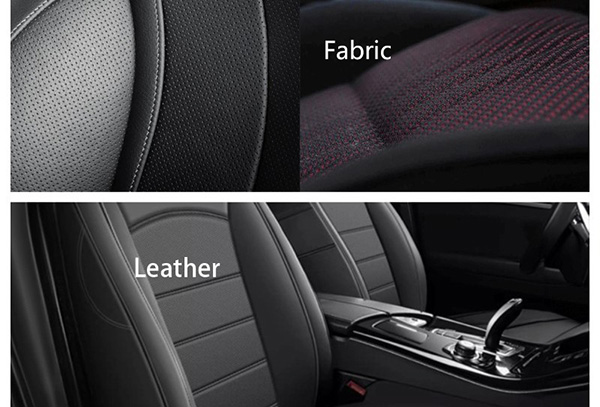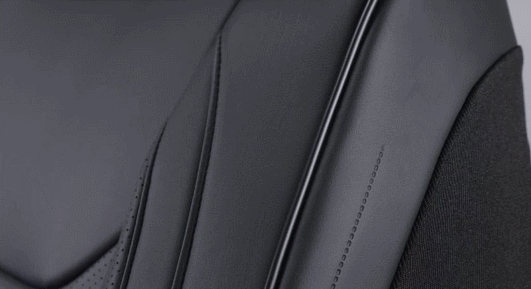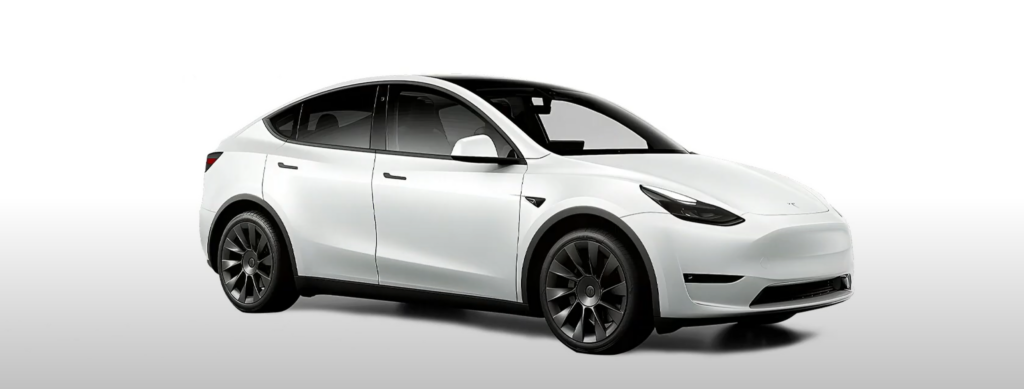When upgrading your vehicle’s interior, one of your most important decisions is choosing between leather and fabric seat covers. This comprehensive guide examines every aspect to help you select the perfect option for your needs, budget, and lifestyle.
1. Material Composition and Quality Variations
Leather Types
- Genuine Leather: Full-grain (most durable), top-grain (balanced quality), and corrected-grain (most affordable)
- Bonded Leather: Recycled leather fibers with polyurethane coating (30-70% leather content)
- Faux Leather: 100% synthetic (PU or PVC) with a leather-like appearance
- Nappa Leather: A full-grain soft leather produced through chrome tanning process, offering 30% better elasticity than standard leather, primarily used in luxury vehicle interiors
Look for thickness measurements – quality leather should be 1.0-1.4mm thick*
Fabric Varieties
- Polyester: Most common, affordable, and fade-resistant
- Neoprene: Waterproof and durable (popular for outdoor enthusiasts)
- Velvet/Microfiber: Luxurious feel but requires more maintenance
- Mesh Fabric: Maximum breathability for hot climates
2. Durability: In-Depth Analysis
Longevity Factors
| Material | Avg. Lifespan | Wear Patterns | Damage Risks |
|---|---|---|---|
| Leather | 8-15 years | Develops patina, minor scuffs | Cracking (if dry), UV damage |
| Fabric | 3-7 years | Pilling, fading, thinning | Stains, tears, odor retention |
Real-World Test Results:
- Abrasion Resistance (Taber test): Leather withstands 10,000+ cycles vs fabric’s 3,000-5,000
- UV Exposure: Leather fades 30% less than fabric after 2 years of sun exposure
- Tensile Strength: Premium leather 2-3x stronger than standard automotive fabrics
3. Comfort and Climate Performance
Temperature Regulation
- Leather:
- Summer: Surface temps can reach 160°F in direct sun
- Winter: Can drop to near-ambient temperatures
- Solution: Perforated leather or ventilated seats improve airflow
- Fabric:
- Stays 20-30°F cooler than leather in summer
- Retains heat better in winter
- Moisture-wicking varieties available
Ergonomic Considerations
- Leather: Firmer support, better for long drives
- Fabric: More cushioning, preferred for daily commuting
4. Cost Breakdown and Value Proposition
Automotive Seat Covers: Value – Cost by Tier
Leather and fabric seat covers offer tiered value propositions. Premium leather provides long-term cost efficiency through extended durability, despite higher initial cost. Mid-range options balance affordability with reasonable lifecycle costs, while performance fabrics offer budget-friendly solutions with moderate longevity. Entry-level fabrics have the lowest upfront cost but may require more frequent replacement. Total ownership costs vary by usage duration and maintenance, with higher-grade materials proving more economical over time. Luxury leather enhances residual value in premium vehicles.
Hidden Costs
- Leather: Annual conditioning, professional cleaning
- Fabric: More frequent replacements, stain treatments
5. Maintenance: Professional Care vs DIY
Leather Care Routine
- Weekly: Dust removal with microfiber
- Monthly: pH-balanced cleaner application
- Quarterly: Conditioning treatment
- Annually: Professional inspection
Common Mistakes: Using silicone-based products, over-conditioning
Fabric Maintenance
- Immediate stain treatment protocol
- Proper washing techniques (temperature limits, drying methods)
- Scotchgard application for stain resistance
6. Special Use Cases
For Pet Owners
- Best Option: Leather with scratch-resistant coating
- Alternative: Heavy-duty canvas with waterproof backing
- Avoid: Looped fabrics that can snag claws
For Families with Children
- Leather Pros: Wipe-clean surface for spills
- Fabric Pros: More forgiving for car seat indentations
- Recommended: Removable, machine-washable fabric covers
7. Installation and Fitment Considerations
Custom vs. Universal Fit
- Leather: Usually requires precise fitting
- Fabric: More forgiving for universal sizes
Installation Challenges
- Leather: May require professional installation
- Fabric: Easier DIY but prone to wrinkling
8. Environmental Impact
- Leather: Carbon-intensive production but long lifespan
- Fabric: Recycled options are available, but shorter replacement cycle
- Eco-Friendly Alternatives: Cork fabric, pineapple leather (Piñatex)
9. Resale Value Impact
- Leather: Increases value by 5-10% for luxury vehicles
- Fabric: Neutral effect when well-maintained
10. Latest Technological Advancements
- Smart Leather: With built-in heating/cooling systems
- Nanotech Fabrics: Stain-proof and antimicrobial treatments
- Hybrid Options: Leather bolsters with fabric inserts
Final Recommendation Matrix
| Priority | Recommended Choice |
|---|---|
| Maximum Durability | Full-grain leather |
| Budget-Conscious | Polyester fabric |
| Hot Climates | Perforated leather or mesh fabric |
| Cold Climates | Wool-blend fabric |
| Easy Maintenance | Protected leather |
| Eco-Friendly | Recycled fabric or vegan leather |
| Luxury Appeal | Top-grain leather |
| Pet-Friendly | Scratch-resistant leather |
Pro Tip: Hybrid Solutions
Many modern vehicles now offer:
- Leather seating surfaces with fabric side bolsters
- Removable fabric covers over leather bases
- Two-tone designs combining both materials
Conclusion
The ideal seat cover material depends on your specific needs:
- Choose leather for unparalleled durability, luxury feel, and easy cleaning
- Opt for fabric if you prioritize comfort, temperature regulation, and affordability
For optimal results, consult an automotive upholstery specialist to evaluate whether leather or fabric seat covers best suit your specific vehicle model and usage requirements before finalizing your decision.

